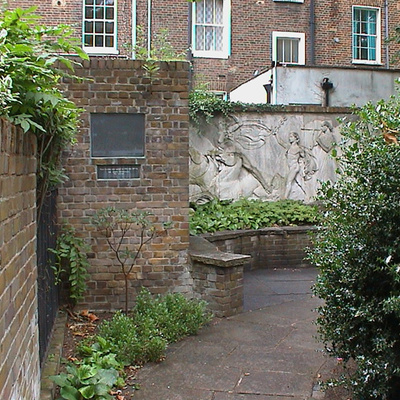From British History: The Hall of Commerce, existing some years ago in Threadneedle Street, was begun in 1830 by Mr. Edward Moxhay, a speculative biscuit-baker, on the site of the old French church. Mr. Moxhay had been a shoemaker, but he suddenly started as a rival to the celebrated Leman, in Gracechurch Street. He was an amateur architect of talent, and it was said at the time, probably unjustly, that the building originated in Moxhay's vexation at the Gresham committee rejecting his design for a new Royal Exchange. He opened his great commercial news-room two years before the Exchange was finished, and while merchants were fretting at the delay, intending to make the hall a mercantile centre, to the annihilation of Lloyd's, the Baltic, Garraway's, the Jerusalem, and the North and South American Coffee-houses. £70,000 were laid out. There was a grand bas-relief on the front by Mr. Watson, a young sculptor of promise, and there was an inaugurating banquet. The annual subscription of £5 5s. soon dwindled to £1 10s. 6d. There was a reading-room, and a room where commission agents could exhibit their samples. Wool sales were held there, and there was an auction for railway shares. There were also rooms for meetings of creditors and private arbitrations, and rooms for the deposit of deeds.
This section lists the memorials where the subject on this page is commemorated:
Moxhay's Hall of Commerce in Threadneedle Street
Commemorated ati
Battishill Gardens
This stone frieze (13 metres long, 2 metres high) was originally unveiled on ...
Other Subjects
Chris Blackwell
Businessman and record producer. Born Christopher Percy Gordon Blackwell in Westminster.
The King's Road
It derives its name from the fact that It was King Charles II’s private road to Kew and wasn’t opened to the general public until 1830. Mary Quant opened her shop ‘Bazaar’ here in 1955. Along with ...
Barber Beaumont
Army officer, painter, philanthropist. Born John Thomas Barber and in 1812 for no known reason, he added the name of Beaumont. He specialised in historical and portrait miniatures, and displayed at...
Previously viewed
Teddington Lock - 1858
TW11, Teddington Lock
We found the punctuation on this plaque so peculiar we have transcribed it exactly. Just shows that way back in 1858 even people in a po...
PP - 3K - Yarman
EC1, Edward Street
The surname was actually Jarman, and the woman that Mrs Jarman tried to save was not her mother, but her mother-in-law.
John Dalton
Chemist, physicist, and meteorologist. Born Cumberland into a Quaker family. Achieved a high level of education early and became a teacher of science at a Quaker college. He made meteorological mea...
C. B. Fry
Sportsman and journalist. Born Charles Burgess Fry in Croydon. Primarily his sport was cricket, but he was also an athlete and played in a football cup final. He taught at Charterhouse School and p...












Comments are provided by Facebook, please ensure you are signed in here to see them